Extreme sister of the Earth. The Past and Future of the Morning Star
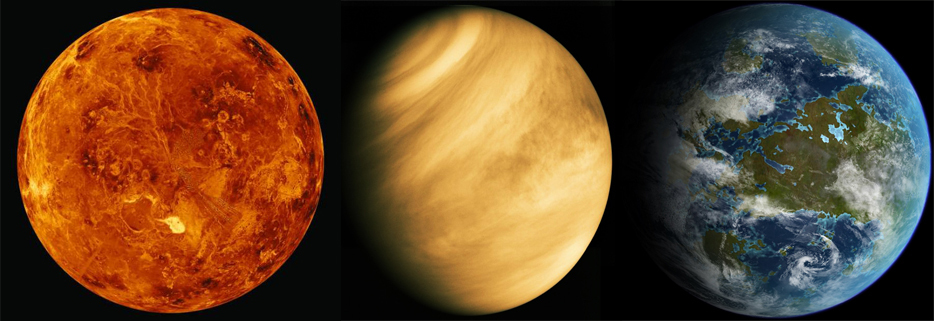
Venus, being the brightest planet in the earthly sky, deservedly bears the name of the beautiful goddess of love of the ancient Romans. But at the same time, it was one of the most annoying disappointments of scientists at the dawn of the space age. The hypothetical tropical paradise actually turned out to be a visual model of meteorological conditions in biblical hell.
Below the cut, we will try to figure out which cosmic and geological processes predetermined such a big difference between Venus and her sister Earth. And also, what actions of humanity in the future can return to the "morning star" the status of a tropical paradise.
')
For the first time, direct data on the physical conditions on Venus were obtained from the flight trajectory of the American station Mariner 2, back in 1962. AMC confirmed the theory of extreme conditions on the "Morning Star", namely, the practical absence of a magnetic field, a strongly heated atmosphere (up to + 500 ° C) and extremely prolonged solar days - up to 120 Earth days. Later, the planet became the object of close attention of the Soviet space program, which unofficially assigned Venus the status of “Russian patrimony”. The beginning of the trend was laid in the 18th century by the Russian scientist Mikhail Lomonosov, who actually discovered the atmosphere of the planet.
“When Venus spoke out of the Sun, when its front edge began to approach the solar edge and was (as a simple eye can see) about a tenth of Venus diameter, then a bump appeared on the edge of the Sun, which became more pronounced the closer Venus came to the performance. Soon the aforementioned pupyr was lost, and Venus was suddenly without an edge. ” May 26, 1761
In the 60s, it was assumed that the atmospheric pressure on the surface of Venus ranges from 10 to 20 atmospheres, therefore the first Soviet landing stations (Venus 3, 4, 5 and 6) were crushed at altitudes of 25-30 km. And only the station Venus 7 , created with the expectation of "vitality" at 540 ° C and a pressure of 150 atmospheres, was able for the first time in history to make a soft landing on the surface of another planet in the 70th year. The data on the conditions in the atmosphere of Venus were radically revised. The pressure is estimated at 90 atmospheres and the temperature at 480 ° C. The "descendants" of this station - Venus 9 and 10, already in the 75th year will pass the first in the history panorama of the surface of another planet.
Landing station AMS Venus 9, on pre-flight trials

Panoramic images of the surface of Venus. Accordingly, the landing stations of Venus 9, 10, 13 and 14. Venus 11 and 12 also landed and regularly worked for more than 100 minutes, but could not transfer the images.
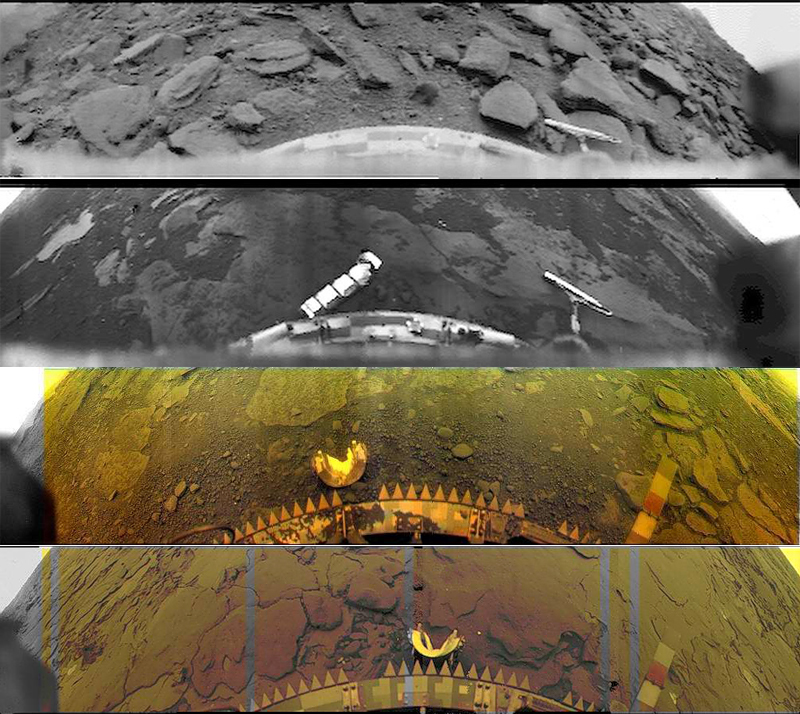
The atmosphere of Venus, along with the Soviet stations, was also studied by the American stations Pioneer-Venus 1 and 2. The measurements gave an estimate of the chemical composition of the atmosphere as 97% CO2, 2% Nitrogen and 0.1% oxygen. The diameter of the planet is 12,104 km, the mass - 81.2% of the Earth. The “powerful clouds” covering the surface from the sun's rays turned out to be a porous haze of 80% sulfuric acid, extending at altitudes of 50-70 km and reflecting up to 75% of the sunlight received by the planet.
Animation of the rotation of the cloud layer of the planet , making a full revolution in 4 Earth days. Despite such a “global hurricane” in the upper atmosphere, wind gusts on the very surface of the planet do not exceed several meters per second. The right scheme of the circulation of the atmosphere of the planet
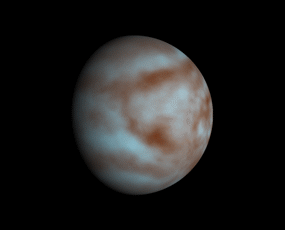
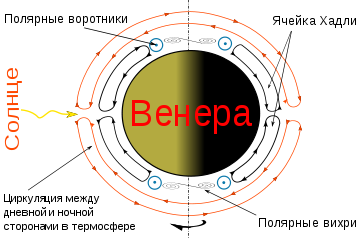
In the 90s, with the help of the Magellan spacecraft (NASA), a detailed radio mapping of almost the entire surface of Venus was carried out. Thanks to these data, as well as the work of the European probe "Venus Express", it became clear that the planet does not possess plate tectonics, its surface is not ancient than 500 million years old and apparently it lost a huge amount of water in a relatively recent past. This was evidenced by a large ratio of deuterium to water molecules, registered by the Venus Express in the upper atmosphere.
"Venus Express" (ESA), twin sister of the Mars apparatus "Mars Express", during a flyby of the poles of Venus in 2012
On Earth, plate tectonics (causing the famous "continental drift") is an important cooling mechanism for our planet. The upper layer of the Earth’s mantle, the asthenosphere, due to the specificity of its structure and the influence of the Earth’s hydrosphere, has a lower viscosity than the mantle, due to which the lithospheric plates slide along the surface of the planet. This kind of active "cooling system" creates a temperature difference between the layers of the mantle, greatly simplifying convection and the transfer of heat from the depths to the surface. Already, in turn, in the center of our planet there is a nickel-iron core heated to 5700 ° C due to the decay of radioactive elements (the most dense compounds fall to the center of a celestial body when planets are formed). Between it and the mantle is a shell of molten matter rich in metals, thanks to convective processes, actively transferring heat from the solid core to the lower layers of the mantle. Convective motion in the molten shell, coupled with the rapid rotation of our planet (dynamo effect), creates a powerful magnetic field that protects our planet from solar radiation and prevents the loss of hydrogen and oxygen ions by the Earth’s atmosphere.
The most interesting passage about the tectonics of the plates of the Earth, clearly explaining their nature
The absence of active plate tectonics on Venus allows us to assume that the heat release by the upper layers of the Venus mantle is limited. There is no significant temperature difference between its layers, therefore, relatively uniform overheating of the inner regions of Venus occurs on geological time scales. Presumably this happened 500 million years ago, when the planet got rid of excess heat through global tectonic activity that renewed the entire surface of the planet. Indirectly, this is indicated by the fact that the planet has no magnetic field, although even the modern rotation period is more than sufficient to generate a significant magnetic field, provided that convective processes occur in the liquid core (which is also allegedly absent from the planet).
It is worth mentioning that Venus has a so-called "false" magnetic field generated by the interaction of the solar wind and the ionosphere of the planet.

Such a difference in the composition of the atmosphere and the internal structure of both planets was most likely predetermined shortly after the appearance of both “sisters” from the gas-dust disk.
The internal structure of the Earth and Venus

According to the generally accepted hypothesis today, the Earth at the dawn of its existence experienced a catastrophic collision with a large planet the size of Mars, which led to the appearance of our satellite, the Moon. This event was not at all exclusive to our star system of that time. The environs of the modern planets were literally flooded with large planetoids, continually colliding with planets and arcs with a friend. At about the same time, a similar collision of Mars with a planetoid with a diameter of 2000 km led to the appearance of a gigantic northern plain. Mercury, in turn, has a “too” massive iron core for the terrestrial planets, and allegedly suffered a collision with a large planetoid or a planet that deprived it of half the mass.
Modeling the ancient collision of the Earth with the planet Theia
For the Earth, the collision with the planet Theia had no lethal consequences. The planet collided with the Earth on a tangent, in the direction of the daily rotation of the Earth, which gave it an additional torque, which was about 5 hours, the tilt of the axis of rotation changed to 23.44 °. Up to 1.3% of the Earth’s mass was thrown into an orbit at a height of 60,000 km, on which the present Moon was formed over the course of a century. The durability of the axial "stabilizer" of our planet was ensured by the fact that the moon rotated in the same direction as the Earth, but much slower. Because of this, the tidal interactions of both bodies gradually alienated the Moon from us, at the same time reducing the Earth day. Today, these values reached 385,000 km and 24 hours, respectively.
The extremely slow daily rotation of Venus is very difficult to explain only by tidal influences of the Sun and the Earth. Usually during the formation of planets, especially large ones, the energy released during the accretion of a substance partly turns into the energy of axial rotation. The daily rotation of almost all planets except Venus and Mercury is within 25 hours. And Venus rotates in the direction opposite to the axial rotation of the other planets. The exception is Uranus, which in antiquity supposedly survived a collision with a planetoid that literally sent the planet into a "knockdown" - Uranus, as is known, rotates lying on its side. To solve the riddle of such a slow daily rotation of Venus, a hypothesis of a giant collision was also put forward, which most likely had to be tangential in the direction opposite to the direction of rotation of the planet.
Huge clubs of fragments thrown into the orbit of the planet could form a rather large satellite, comparable in size to the Moon. However, since the satellite rotated in a retrograde orbit (in the direction opposite to the rotation of the planet), the tidal interaction of both bodies already led to deceleration as the satellite itself, and slower rotation of Venus. In the end, the satellite crossed the limit of Roche, where the gravitational forces of the planet destroyed the satellite, and debris struck Venus. According to another model, the blow fell at such an angle that Venus literally turned over "upside down", having lost almost the entire moment of axial rotation.
A similar process is taking place today between Mars and its satellite, Phobos. Since the red planet rotates slower than Phobos, the latter gradually loses its orbital moment, and presumably will fall to Mars over the next 11 million years.
The extremely slow rotation of Venus does not allow anything to linger (in geologically long time) on its orbit. According to one hypothesis, the “culprit” of such a meeting could be Mercury, who allegedly lost most of his mass from a collision with a planet mass with Venus . This hypothesis is easier to explain at once two points - where did the "excess" mass of Mercury go, and where the planetoid that faced Venus "disappeared". The first formed, together with the debris of Venus, a large satellite, which then fell on the planet, and Mercury, having lost its orbital moment from a blow, moved to a lower orbit.
Mercury has a disproportionately large iron-nickel core in relation to the mass of the planet. It also, due to the tidal influence of the Sun, generates the magnetic field of the planet, which is 100 times weaker than the Earth’s

The slow daily rotation of Venus led to overheating of the ancient Venusian oceans, the existence of which was confirmed by the Venus Express, and increased the decomposition of water molecules into hydrogen ions and oxygen by ultraviolet rays of the sun. Because of the extremely weak ancient magnetic field of the planet, hydrogen left the planet (dissipation), and the solar wind, freely reaching the atmosphere of the planet, only strengthened the effect, blowing light elements into space. Oxygen was associated with surface rocks, but even now its absolute mass in the atmosphere of Venus is inferior to the earth's atmosphere only three times. Saturation of the atmosphere of Venus with water vapor only increased the greenhouse effect, which already increased due to the atmosphere consisting of CO2. Such a positive feedback in a geologically short time greatly heated the atmosphere of the planet. The hydrosphere has evaporated, plate tectonics has ceased, and the processes that are not completely clear today have led to the stopping of convective processes in the core of the planet. Venus has lost an already weak magnetic field, if it ever had a planet.
A modern map of Venus, compiled based on the results of the orbital radar of Pioneer-Venus , Venus 15, 16 and Magellan stations

About 4 billion years ago, the Earth received from the young sun only 70% of the energy that it receives today. Therefore, unlike Venus, the greenhouse effect given by CO2 and methane (biogenic origin) then contained in the atmosphere rather played a positive role, preventing the ancient oceans from freezing. In turn, the rapid daily rotation of our planet did not allow these oceans to overheat.
Subsequently, the level of greenhouse gases steadily fell in parallel with the increase in energy received by the Earth from the Sun. To date, almost all of the primary CO2 has been processed into carbonate sediments and biomass. The hydrosphere of the planet as a result is preserved, and along with it the plate tectonics. Despite the faster rotation of the planet (4 times faster than today) and more active convection processes in the core and the mantle in ancient times, the current magnetic field of the Earth is about twice as powerful as its oldest predecessor .
The Taming of the Shrew
Hypothetical view of terraformed Venus
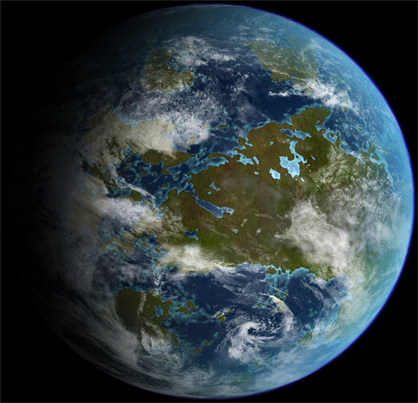
Due to the extremely difficult climatic and geological conditions on the planet, it is proposed to use a combined approach for its development:
1. To carry out an exact bombardment of the planet, preferably with iron asteroids, to reduce the duration of solar days, as well as to “clean” the atmosphere from sulfuric acid vapor. Bombardment to produce just a large number of medium-sized asteroids, in order to avoid the destruction of the crust of the planet.
2. Installation of a huge screen at Lagrange point L 1 of the planet, preventing sunlight from reaching Venus, which will lead to the cooling of the atmosphere and the loss of all CO2 in the form of “dry ice”. The second option involves only reducing the temperature to an acceptable level, for delivering a large amount of water to the surface — with a pressure of 90 bar, the water does not boil to a temperature of 300 ° C.
After cooling the planet, such a shield could be divided into several elements and rotate around the Lagrange point L 1 in such a way as not to prevent the sun's rays from reaching the planet's atmosphere. In the early stages of terraforming, such shield characteristics could control the amount of solar radiation reaching Venus and at the same time generate tremendous amounts of energy (when assembling a screen from photoelectric converters).
3. After the water is delivered to Venus, most likely by bombarding it with comets (several tens of thousands, or about 100,000 comets the size of the nucleus of Halley’s comet), it will be necessary to maintain a high atmospheric pressure until the temperature of the atmosphere drops to an optimum next stage.
The second option is to first cool the planet to an acceptable temperature, and then carry out a comet bombardment that would simultaneously solve two problems - the delivery of water and the spin of the planet.
4. One way or another, for human life on the surface of the planet, it is necessary to get rid of 99% of the mass of its very dense atmosphere (which is 4.85 x 10 ^ 17t!). For these purposes (perhaps in addition to artificial purifiers of the atmosphere), hyperextremophiles are well suited - the simplest archaea (or their future artificial modification) that can comfortably exist up to temperatures of 100 ° C. They can split the planet's atmosphere into carbonate deposits (1.35x10 ^ 17t) and free oxygen (3.5x10 ^ 17t). If we deliver 3.85x10 ^ 16t of hydrogen to Venus and combine it with all this “excess” oxygen, we will get a huge mass of water, which is 1/3 of the mass of the Earth’s oceans!
5. To protect these oceans and future life from solar radiation fluxes, an artificial magnetic field of the planet will be created; one of the options involves placing cables from a superconductor along the equator of Venus.
6. The last stage is likely to consist in the subsequent cooling of the planet, the final “tuning” of the physical characteristics, the composition of the Venusian atmosphere and the creation of the biosphere, and artificial life can make a significant contribution to any of the 6 stages of terraforming.
Estimated Venusian Hydrosphere Map after Terraformation
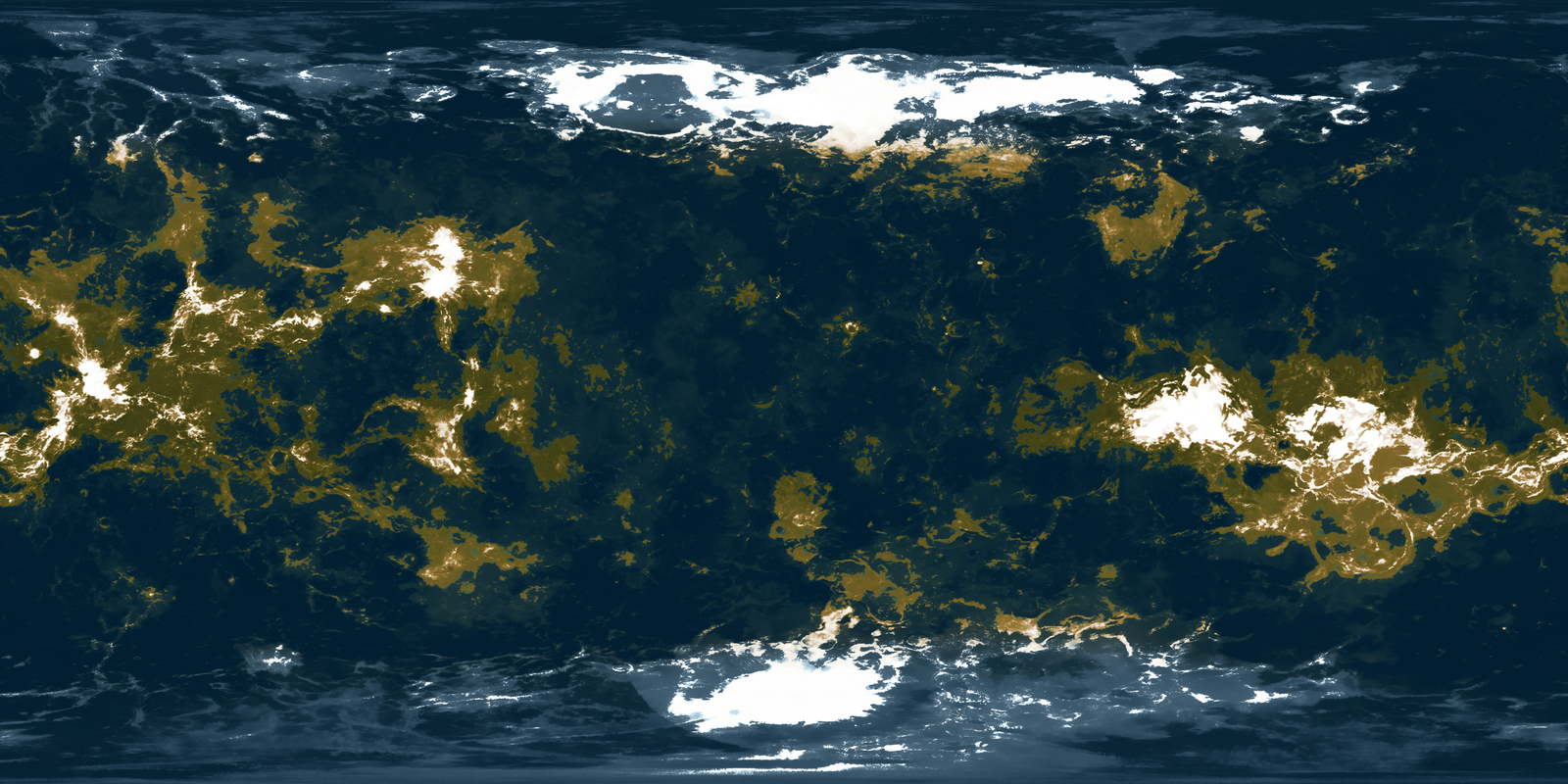
All of the above requires a much more advanced level of science and technology, knowledge of the fundamental principles of planetary planetology, geology and genetics, inaccessible in our time. It is quite possible that today's assumptions about the methods of terraforming the planets will seem somewhat naive to our descendants, or, conversely, some points will turn out to be prophetic.
We only need to hope that a person in any century will cancel the harsh sentence imposed by the mother nature of this “goddess of Beauty”.
If you are interested in the research topic of Venus, I advise you to get acquainted with the following works:
NEW EPOCH IN VENUS RESEARCH
Venus or the first 60 kpx from another planet
Space Odyssey: Earth - Venus - Halley's comet (they knew how to write cool in the USSR)
Book about venus
Source: https://habr.com/ru/post/231251/
All Articles